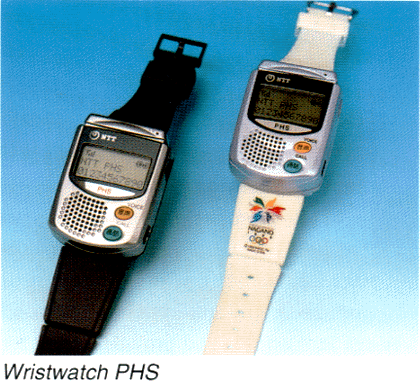NTT Develops Wristwatch PHS

No,
that guy on the corner isn't necessarily holding a conversation with
his
wristwatch. From NTT comes a lightweight,
compact, voice-activated
PHS unit that you can strap to your wrist.
by Noriko Takezaki
The US may have taken an early lead in the
development of "wearable
computers," acknowledges NTT (Nippon
Telegraph and Telephone Corp.), but
that is not the case when it comes to wearable
communications tools. To prove
it, NTT has announced a wristwatch-type PHS
(personal handyphone system)
unit featuring a voice-recognition dialing
function so that the user can place a
hands-free call.
"The Japanese are good at producing
very compact and sophisticated tools,"
says Tetsuma Sakurai, senior research engineer
at NTT's Speech and Acoustics
Laboratory. "So there is high potential
that Japan can lead the world in the field
of wearable communications devices."
A "wristwatch" PHS unit
NTT's compact "wristwatch" PHS
unit (also available with a necklace pendant
case) contains an embedded LSI chip and miniature
lithium-ion battery; it
weighs just 45 grams. The user can activate
the unit's hands-free voice-dial
function by preregistering the phone number
to be dialed with his or her own
voice into the PHS memory. The unit's dialing
function is then activated by
announcing either the number to be dialed
or its associated registered name,
such as "uchi" (my home) for the
user's home phone number, into the PHS
microphone.
According to NTT, the unit's voice recognition
function can handle any
language, so long as the voice-dial registration
was done in that language. The
PHS also supports pushbutton input of abbreviated
(quick dial) numbers.
NTT's Sakurai says that the key to the unit's
success lies in its LSI chip, which
enables high voice recognition performance
and suppression of howling (noise
picked up by the microphone from the unit's
speaker), as well as low power
consumption and low cost. "The voice
recognition precision of this PHS unit is
quite high," he claims; "more than
95% precision in a quiet indoor setting, and
70% to 80% even in a noisy outdoor environment."
The LSI consists of an MT-CMOS (Multi-Threshold
Complementary
Metal-Oxide Semiconductor) device and incorporates
two transistors with high
and low threshold values. The transistor
with the higher threshold functions as a
barrier against current leakage during circuit
idling, while that with the lower
threshold is used during normal operation.
This helps reduce the device's power
consumption and enables the unit to support
calls of up to 60 minutes duration
or to function for 100 hours in standby (call-available)
mode.
With the cooperation of a semiconductor manufacturer
(Sakurai would not
disclose the name, saying only that NTT had
evaluated both foreign and
Japanese RISC chip manufacturers), NTT spent
one year designing and
developing the requisite LSI. Sakurai recalls
that the critical point in selecting a
chip manufacturer was not the performance
of the chips themselves, but the
availability of an evaluation toolkit (including
simulator, emulator, in-circuit
emulator, and target board) to assess the
application development work at
NTT. Even though some companies offered chips
with excellent performance,
few offered an adequate evaluation tool kit,
notes Sakurai. "This is something
that semiconductor manufacturers should seriously
consider [to extend their
market share]," he says.
An Olympic field test
NTT has a long history in voice recognition
R&D, dating from the early 1980s.
NTT researchers were confident, therefore,
of their level of technology; they
were not so sure, though, about the commercial
application of this technology to
a wearable PHS unit. The basic question was
whether people would be willing
to speak into a wristwatch PHS in public.
For those too shy to speak loudly into the
wrist unit, NTT developed a compact
earphone-type microphone/receiver. The optional
earphone unit features
separate microphones for better voice transmission
-- one that picks up the
user's voice normally through airborne sounds,
and one that picks up voice via
conduction by the speaker's facial bones.
During the product's field trials, carried
out at the Nagano Olympic Games site
in February, NTT was pleased to find that
the number of people willing to use
the wristwatch PHS unit far exceeded its
expectations. Moreover, few of the
field trial users bothered to employ the
optional microphone/receiver unit.
Sounding out the future
NTT is the first to apply voice-recognition
technology to a wearable PHS unit.
It is too early to say, though, whether PHS
will be a key player in the wearable
communication device market of the future.
That shouldn't pose a problem,
since the technology can be easily applied
to cellular phone systems as well.
The main reason that NTT selected PHS to
showcase its voice recognition
technology at this time was in part to widely
promote PHS, including at the
Nagano Olympic site where the field trials
were conducted. NTT is eager to
improve the image of PHS, which has often
been criticized for poor
performance and connectivity, and thus help
its money-losing PHS affiliates.
NTT says that its target for commercialization
of a voice-activated PHS unit is
two years. For successful market release,
however, the product still requires
some improvements, such as cost reduction
to the level of standard PHS units
(in the ´20,000 range) and an improved terminal
design that offers easy
operation (current button operation remains
slightly complicated). NTT's
voice-recognition technology is first rate,
but high quality
Technology alone doesn't sell products. Ultimately,
the most important factor
for successful sales of NTT's wristwatch
PHS will be the short-and long-term
success of Japan's PHS market..
From http://www.cjmag.co.jp/magazine/issues/1998/june98/phs.html
Contact Greg Blonder by email here - Modified Genuine Ideas, LLC.